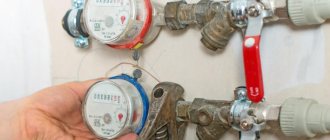Housing and communal services
12
The year 2009 can be considered the beginning of mass installations of energy consumption meters. With the adoption of the law of November 23, 2009 No. 261-FZ “On energy saving and increasing energy efficiency,” a number of changes were made to legislative acts. Now apartment owners are required to install resource consumption meters: electricity, gas, water in their living quarters.
The Law specifies the deadline for installing water meters - until July 1, 2013 (clause 12 of Article 13), but it is constantly being pushed back. With the entry into force of the document, many owners of residential space began to actively install them. This was facilitated by the active activity of companies offering to carry out work on favorable terms.
However, those who are still in no hurry to acquire a water meter should take into account that the government has introduced penalties for non-compliance with legislative norms. This will be done in the form of a constant significant increase in tariffs, which will force the population to switch to water metering.
When is it necessary to install water meters in 2021 according to the law?
As mentioned earlier, installing water meters is our responsibility by law. Therefore, despite talk about the possible abolition of this norm, it is hardly worth expecting. No one can directly punish residents who do not want to install a meter or do not have the funds to do so. But rising tariffs can hit your pocket hard.
As a result, all that remains is to calculate all the costs for the individual metering devices themselves, their installation and monthly fees and compare them with what awaits residents in apartments without them in 2021. In such housing, the fee for water consumption is calculated by multiplying the standard tariff approved by local authorities by the number of registered people in a given living space.
Every year an additional factor will be applied to the tariff. In 2021, the increasing coefficient for water without a meter remains the same, as in 2021, according to Resolution No. 354 of May 6, 2011 “On the provision of utility services to owners of apartment buildings”, effective from December 27, 2018.
Thus, in 2021, those who have not installed water meters will pay 50% more for consumption, that is, the increasing factor will be 1.5. This puts a significant strain on the family budget.
Among other things, management companies are responsible for the extent to which the Law is complied with in the houses entrusted to them. Their task is to achieve the maximum number of apartments equipped with water meters. Therefore, they are actively working in this direction, sometimes even providing payment in installments for several months.
With the installation of devices, you will lose the headache of a management company insistently demanding to do this, and a significant reduction in water charges, since it will directly depend on actual consumption.
To install a water meter, you must submit an application to the management company. If it does not have permission for this activity, it is obliged to provide a list of organizations providing this service.
For owners of municipal housing, water meters are installed free of charge ; for privatized apartments, the cost can vary between 4,000-7,000 rubles .
After installation, it is necessary to invite a representative of the management company, who will draw up a commissioning certificate and put a seal. Sealing is a free service.
Do you know who should install a communal heat meter in an apartment building?
When to install water meters in a new building and who should do it?
The installation of individual metering devices (meters) falls within the norms of current legislation. Federal Law No. 261-FZ obliges the use of them, because this will entail significant savings in energy and water resources, and will also allow keeping records of their consumption.
As for new buildings put into operation after the Law came into force, they must definitely be equipped with all the necessary meters: gas, water and electricity. This means that all residential premises must be put into operation with such devices.
Development companies must install water meters in the quantity required for a specific apartment, that is, for each water supply pipe, both cold and hot, as well as a common house meter. Residents must pay attention to this when inspecting the premises and not sign the transfer deed in their absence. If they are not there, then this fact must be reflected in the document or written notification to the developer, who is obliged to correct the situation.
It is also worth noting the fact that without water meters, housing being put into operation cannot be accepted by the state commission. This means that the very fact of acceptance by the commission will not allow apartments in the building to be sold and occupied.
Procedure after completion of work
After completing the installation work, you must receive documents from the master:
- certificate of completion;
- technical passport, accompanying documents of the new launcher;
- a receipt confirming payment for installation services;
- certificate of compliance of the device with quality standards and norms.
Next, these documents are sent to the DEZ, then to the Unified Settlement Center. Registration takes place there, the device is registered and the amount of utility bills is calculated based on its readings.
Without registering a water meter, calculations will be made according to standards for the number of residents without taking into account indicators.
It is also necessary to invite a specialist inspector who will assess the correctness of the installation, seal the control panel and officially put it into operation.
Service life of water meters in apartments
The metering device for water consumed by residents is a measuring device and may become insufficiently accurate over time. This distorts the actual numbers by making them smaller or larger.
In order to prevent such discrepancies, rules and deadlines for checking water meters have been introduced. They are:
- for cold water – 6 years,
- for hot water – 4 years.
If the check shows that the measuring tool is in good working order, you can continue to use it until the next check, otherwise it should be replaced. Please note that the average service life of water meters is 12 years.
The homeowner himself is obliged to monitor the end of the inter-inspection period and promptly contact specialized organizations involved in inspection and issuance of the relevant act. You can find out the expiration date of such a period from the meter installation report or the previous verification report. We do not recommend postponing the verification procedure until the last few days, but take care of it in advance.
The result of meter verification must be provided to the management company without fail. If the deadline passes and the documents are not received, then she has every right to charge for water based on the standards applicable to apartments where metering devices are not installed.
Benefits from using water meters
Knowledge of tariffs and consumption standards will help you calculate how profitable it is to pay for water supply services by meter.
For example, in Moscow these indicators are:
- hot water, r./m3 - 198.19;
- cold water, r./m3 - 40.48;
- water disposal, r./m3 - 29.57.
The monthly usage rates here are 6.935 m3/person. for cold water and 4.745 m3/person. for hot. Simple calculations will help you compare monthly payments according to PU indicators and according to standards.
Let’s take the average usage data for a family of three:
| Type of service | According to PU | According to standards |
| HVS | 5,5*40,48=222,64 | 6,935*3*40,48=842,186 |
| DHW | 5,2*198,19=1030,588 | 4,745*3*198,19=2821,235 |
| Water disposal | (5,5+5,2)*29,57=316,399 | (6,935+4,745)*3*29,57=1036,133 |
| Result: | 1,569.627 rubles | 4,699.55 rubles |
As can be seen from the calculations, the use of water meters can reduce the cost of services by three times.
Even though the cost of a water meter and its installation makes adjustments to expenses (plus mandatory periodic verification), the use of PU water is inappropriate only if many more people live in the room than prescribed. And you can install the PU yourself.
We’ll talk about the benefits in this article, and about self-installation here.
How are water meters checked?
Checking can be done in two ways:
- Without removing the meter. Specialists go to the site and perform water meter tests. As a result, the owner receives a certificate indicating the date and test results. This is convenient for residents - you just need to provide unhindered access to the meter - and requires minimal time.
- With the counter removed. Representatives of the company dismantle it, take it to the laboratory and take measurements there. If they find a small problem with the mechanism, they can fix it and install the meter back. In the case where the meter is checked on site, nothing can be corrected. Therefore, the master may offer to remove it and take it for repairs or issue a certificate with a conclusion on replacement.
The easiest way is, of course, the first. It does not require disconnecting the riser to remove the device and wait for reinstallation. This can take from several hours to several days. To avoid any questions regarding the quality of the inspection, immediately check with the company whether it has the appropriate permits for this type of activity.
Verification is a paid service. The cost of checking one meter can be within 1000 rubles .
Rules for installing water meters in a private house in 2021
The installation of water meters is subject to a number of rules and regulations. They are almost the same for both residents of apartment buildings and private residential buildings. Therefore, we list what rules must be followed when installing water meters:
- It is necessary to use only devices that have been certified in Russia. Each must be accompanied by a technical passport. The serial number contained in this document must match that printed on the meter body. There is no need to reset the readings on the display, since they will be recorded during sealing and will become the starting point for measuring water consumption.
- A coarse filter must be cut into the pipe up to the installation site of the meter. This is necessary for the device to last longer. The water coming from the water supply may contain dense particles, leading to rapid wear of the water meter, or more precisely its mechanical parts. The presence of a filter reduces the likelihood of various problems and increases the accuracy of the device.
- The meter must be sealed, otherwise its readings will not be considered valid. They are sealed in an apartment by a representative of the management company, and in a private house - by a water supply organization. The cost of the service is free by law.
- A certain distance must be maintained, which is no more than 20 cm from the entrance to the pipeline to the meter. This is a necessary condition so that the owner cannot independently connect to the meter.
- The meter must be installed in a private house in a room into which a pipe from the central pipeline is led. It should run along the wall. In this case, the air temperature in the room should not be lower than 5 degrees. If the water main is located quite a distance from the house, then you will need to install a meter on the street. In this case, a special well is built where it is placed. Then not only the meter itself is sealed, but also the lid with which the well is closed. Breaking the seal on the lid is only allowed in the event of an accident or fire. The owner of a residential building is responsible for the condition of the pipeline from the location of the water meter to the house itself.
What errors occur and how to avoid them?
Typical errors that occur during installation:
Confused entrance and exit .
If the device is installed opposite to the water flow, it will show only nines. This means that the PU turns in the opposite direction. Prolonged use in the wrong position will cause damage.Therefore, when installing, you need to carefully monitor where the flow enters the device from. The entrance is often marked with an arrow or color indicator.
- Poor sealing of fasteners . As a result, leaks may occur. The readings will also be incorrect. This is why it is so important to check the tightness upon completion of work and for several weeks after installation.
- They blocked the wrong pipe before installation. A stream of water flooding everything around will quickly indicate an error. Such situations rarely arise with great absent-mindedness.
The described actions and attentiveness of the owner will help protect against such missteps.










